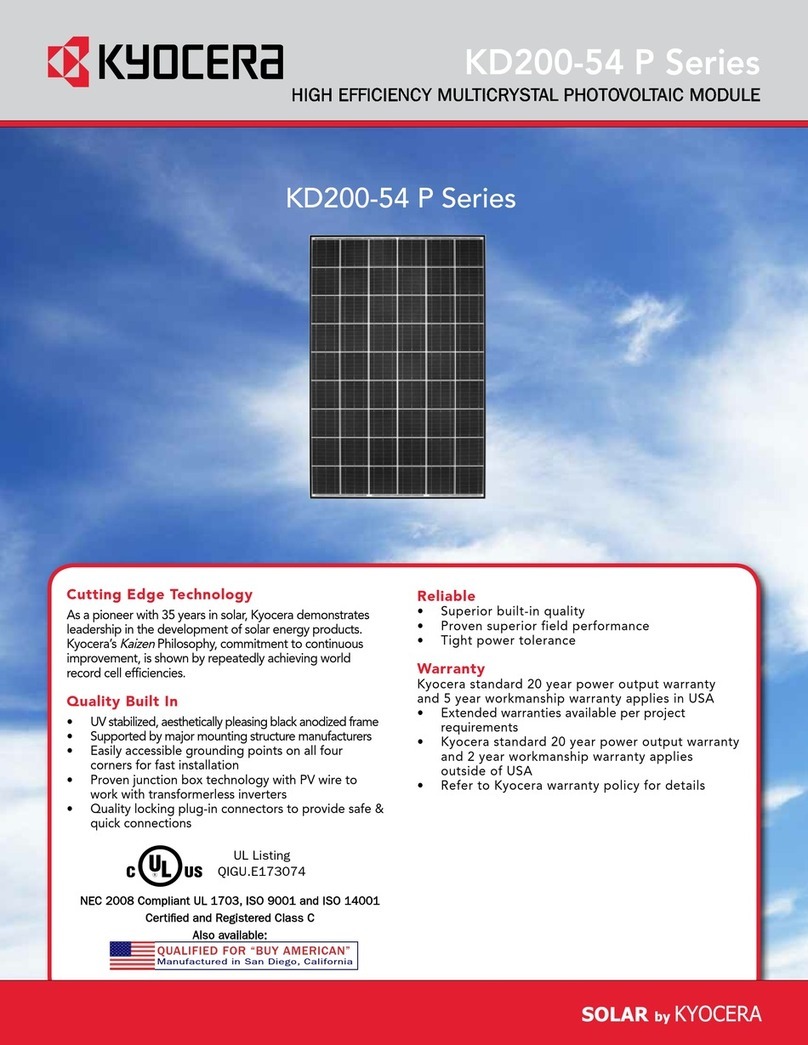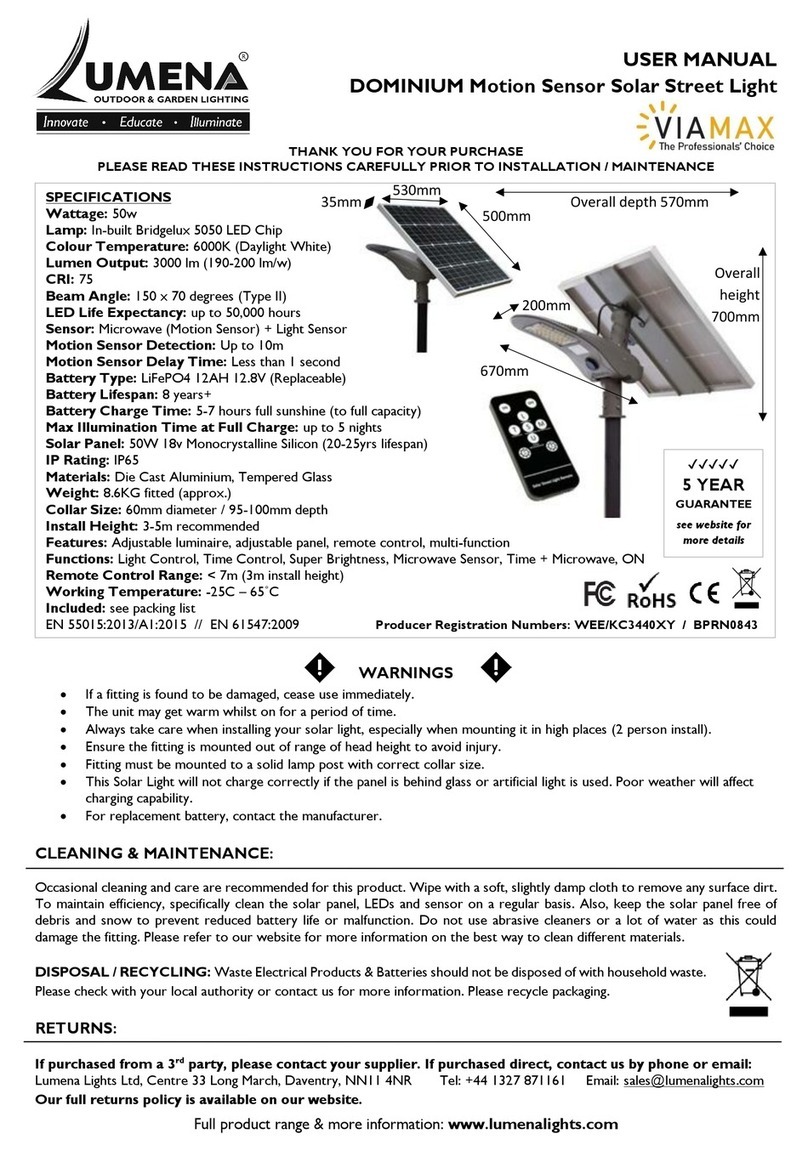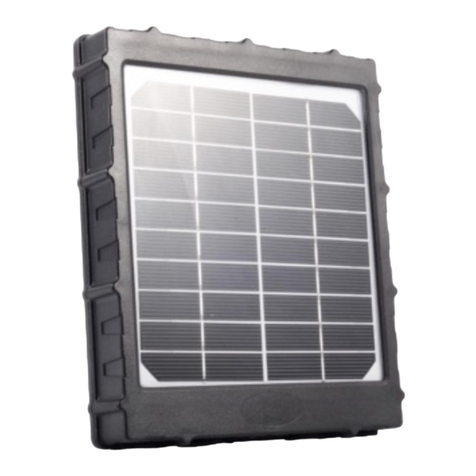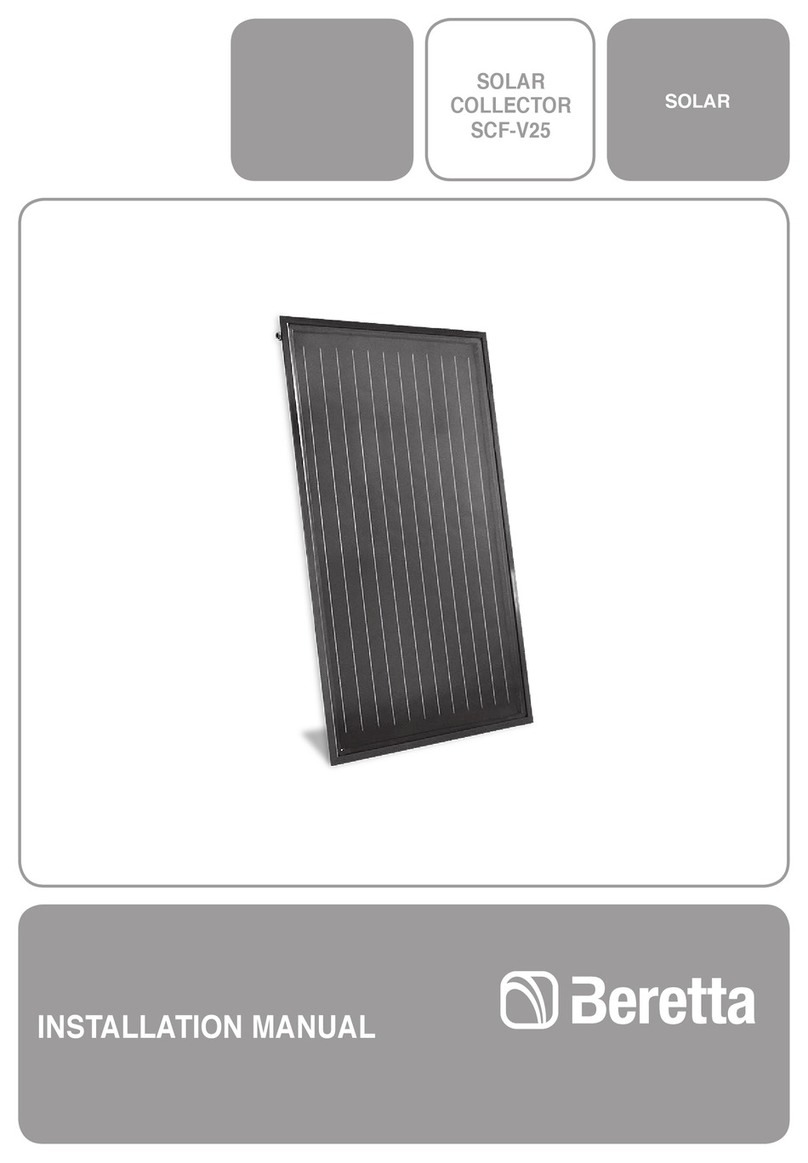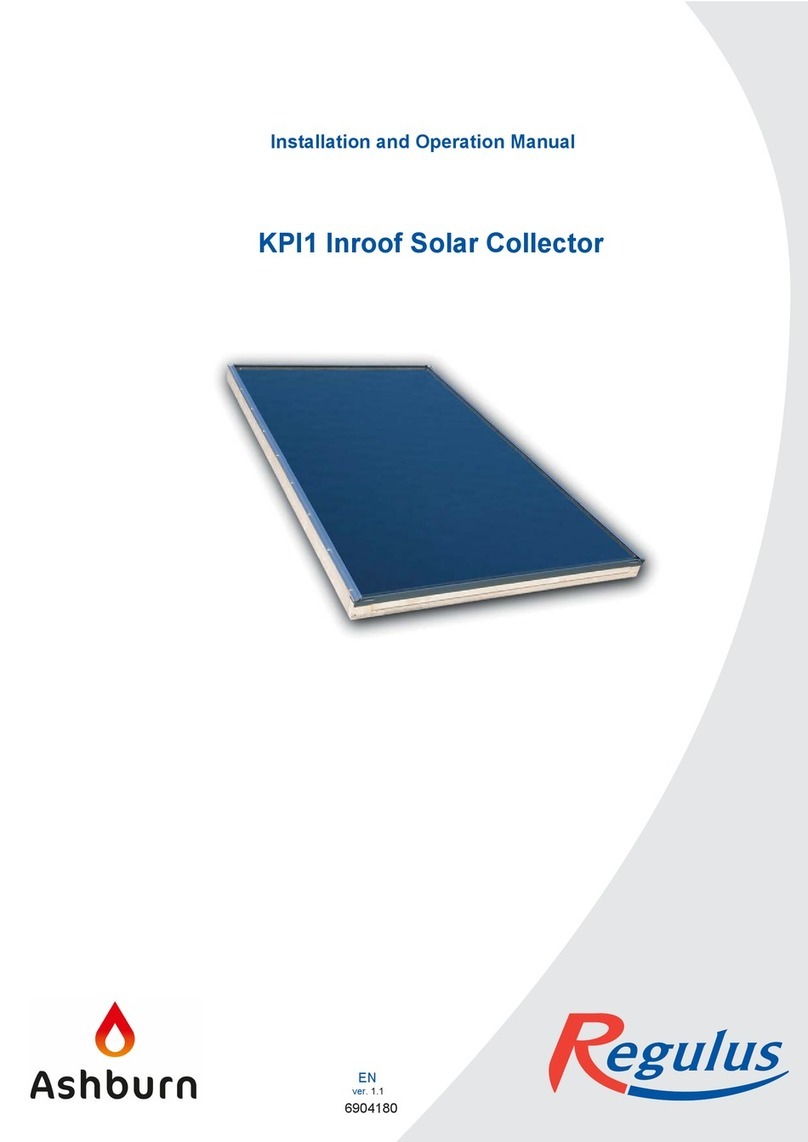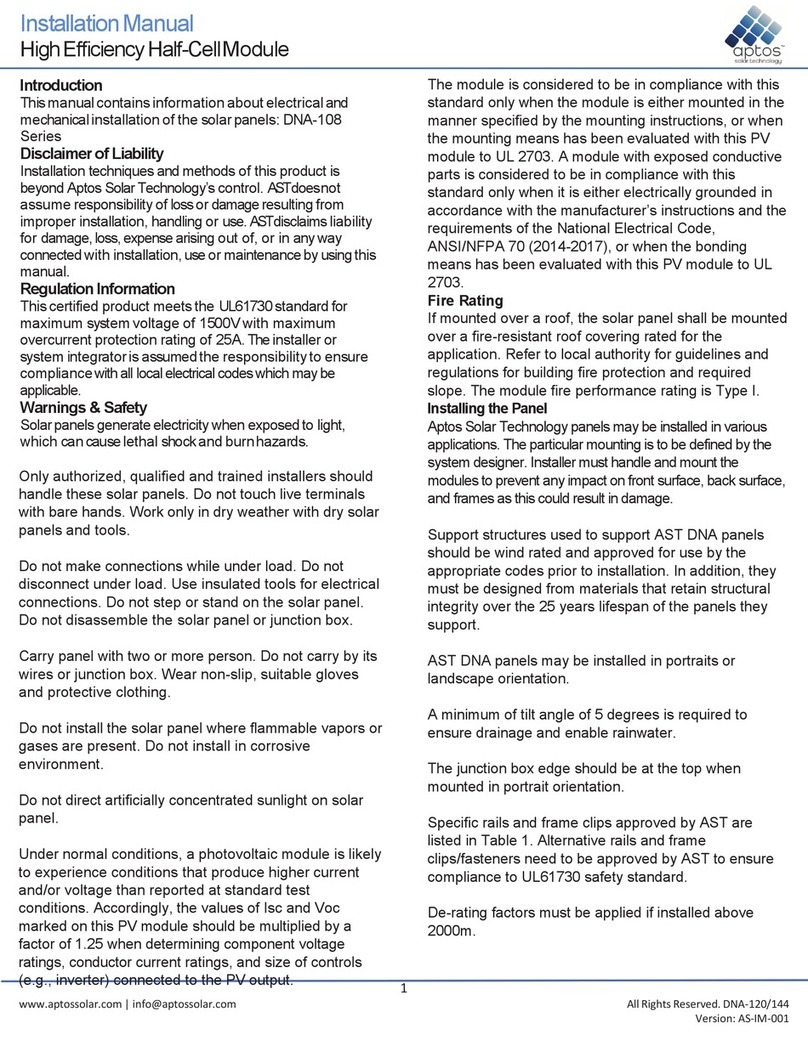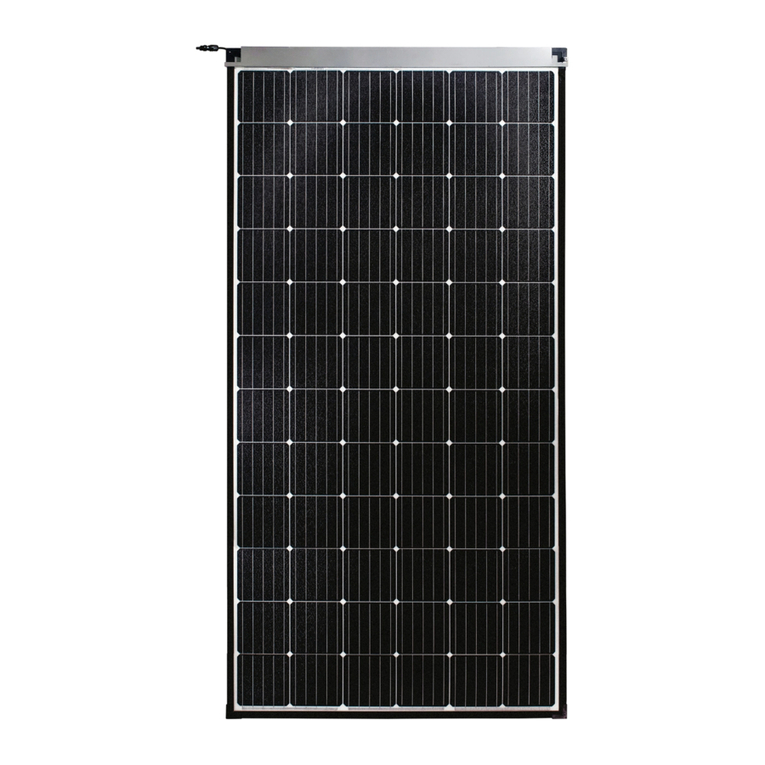DGSI SolarNAPL Technical Document

Installation, Operation and Maintenance Guide
SolarREM – Solar Powered Remediation Technologies.
The first truly “environmental” remediation product.
Version 2.1
SolarNAPL
TR-51600

Table of Contents:
Chapter 1
Installation, Operation and Maintenance............................... 1
Specifications ........................................................................ 2
Technical Support.................................................................. 3
Chapter 2
About the SolarRem.............................................................. 4
Chapter 3
About the Components.......................................................... 5
Chapter 4
Safety Information ................................................................. 6
Chapter 5
Installation Instructions.......................................................... 7
F.A.Q.’s.................................................................................. 8
Chapter 6
Setup Instructions.................................................................. 10
Chapter 7
System Configuration / Operation ......................................... 23
Chapter 8
Troubleshooting..................................................................... 24
Chapter 9
Additional Components ......................................................... 26

SolarREM identifies the three provided for assistance in bioremediation of contaminated sites, remote from an
economical power supply, not quickly accessible, and subject to long term remediation requirements.
1) The SolarNAPL provides pneumatic pumping capabilities for removal of LNAPL contaminants laying
on the ground water table. It is provided with a storage tank level sensor to shut the system down when
full to prevent a surface spill.
2) The SolarPurge provides pneumatic pumping capabilities for low flow groundwater pumping.
3) The SolarSPARGE provides higher air flow into the ground water table to promote bioremediation and
volatilization of LNAPL contaminants in the groundwater.
Chapter 1
About the SolarRem Product Family
Inspection
Installation, Operation and
Maintenance Guide Introduction
SolarREM – The First Truly Environmental Remediation Product
Upon receipt of shipment at the job site, carefully check the shipment against the bill of lading. Make sure all units
have been received. Inspect the carton or crating of each unit and inspect each unit for damage. Repackage unit
after verifying that all components are included. Assure that the carrier makes proper notation of any shortages or
damage on all copies of the freight bill and that he completes a Carrier Inspection Report. Concealed damage not
discovered during unloading must be reported to the carrier within 15 days of receipt of shipment. NOTE: It is the
responsibility of the purchaser to file all necessary claims with the carrier. Notify DGSI of all damage within fifteen
(15) days of shipment.
Unit Protection
Cover units on the job site with either shipping cartons, vinyl film, or an equivalent protective covering. Cap the
open ends of pipes stored on the job site. In areas where painting, plastering, or the spraying of fireproof material
has not been completed, all due precautions must be taken to avoid physical damage to the units and contami-
nation by foreign material. Physical damage and contamination may prevent proper start-up and may result in
costly equipment clean-up. Examine all pipes, fittings, and valves before installing any of the system components.
Remove any dirt found on these components.
Storage
Upon the arrival of equipment at the job site, immediately store solar panel units in their shipping cartons in a
clean, dry area. Store units in an upright position at all times.
CAUTION: Do not store or install units in corrosive environments. Corrosive conditions and
high temperature or humidity can significantly reduce performance, reliability and service life.
1.

Specifications
The SolarREM units are designed to provide operating capabilities in remote locations away from the power grid,
and to be operated in a simple fashion, both in setup and in operating mode. The units are designed for a no
shock or explosion hazard environment.
A deep cycle battery is provided to withstand the rigors of weather and deep power draw. The solar panel pro-
vides recharge of the battery to permit a longer operating period of the units.
A low draw DC powered compressor pump provides the necessary compressed air for all configurations.
The standard base model as supplied by SolarREM is designed to provide a sturdy low maintenance air compres-
sor providing adjustable timing to maximize the off cycle to the conditions of the site.
The battery and solar panel are sized to maximize operating time, providing up to 2 days operations during peri-
ods with minimal sunlight (heavy rain). The solar panel ensures quick recharge to get the battery back into opera-
tion as the result of a long low sunlight period.
A 7.5 gallon ASME air receiver tank is standard to provide optimum compressor pump operation and minimize
on / off cycles that result in large battery draw.
2.

Technical Support
Information presented in this publication has been carefully checked for reliability. However, no responsibility is
assumed for inaccuracies. The information contained in this document is subject to change without notice.
If a problem arises with your system, you should turn to your dealer or the manufacturer for help first. Your sys-
tem has most likely been configured by them, and they should have the best idea of what your system contains.
Hence, they should be of the most assistance. Further, if you purchased your system from a dealer near you,
you can bring your system in to them to have it serviced instead of attempting to do so yourself (which can have
expensive consequences).
Our web page: www.durhamgeo.com
Technical support phone line: (800) 837-0864
Durham Geo Slope Indicator
2175 West Park CT. Stone Mountain, Ga 30087
Returning Merchandise for Service
During the warranty period, contact your distributor or system vendor FIRST for any product problems. This war-
ranty only covers normal customer use and does not cover damages incurred during shipping or failure due to the
alteration, misuse, abuse, or improper maintenance of products.
For Resellers Only:
A receipt or copy of your invoice marked with the date of purchase is required before any warranty service can
be rendered. You can obtain service by calling the manufacturer for a Return Merchandise Authorization (RMA)
number. The RMA number should be prominently displayed on the outside of the shipping carton and the package
should be mailed prepaid, or hand-carried to the manufacturer. SolarREM will pay to have the unit shipped back
to you.
Disclaimer
Information presented in this publication has been carefully checked for reliability. However, no responsibility is
assumed for inaccuracies. The information contained in this document is subject to change without notice.
3.

Chapter 2
About the SolarREM
The SolarREM is a solar powered remediation unit capable of either free product recovery system (SolarNAPL,
SolarPURGE, SolarSKIM), fluid injection (SolarDRIP) or pressurized air (SolarVent, SolarSPARGE). The unit is
capable of running up to 2 days without sunlight. By relying on solar power, SolarNAPL can be installed in any
location where a power supply necessary to run traditional pumping systems is not economically available.
SolarNAPL is a self-contained remediation system consisting of a solar panel, battery, air compressor and pump
and associated wiring and controls. The solar panel charges the battery, which serves as the power supply for the
air compressor and the system controls.
When activated, the compressed air is discharged to the pneumatic pump, forcing the product up the pump dis-
charge hose and into a holding tank. The operating characteristics and performance of the SolarNAPL is deter-
mined in part by the specifications of the solar panel, battery and pump. Operating parameters such as the reset
time (no air to pumps) is adjusted with the electronic timer.
To operate correctly and efficiently, air must be pumped into the pneumatic pump at a pressure sufficient to dis-
place the water column and overcome frictional losses in the system. The injected air displaces the product col-
lected in the pump and discharges it to the collection system. This air and product cycling continues in the pump
while the air is available.
Technical Description - Overview
The power supply for SolarNAPL consists of a photo-voltaic array and battery. The photovoltaic cells use sunlight
to charge the battery. The battery in turn powers the system controls and, the air compressor pump. The pump
fills an air receiver tank that provides the pressure and volume of air required to displace the product in the pneu-
matic pump.
A voltage regulator is used to prevent the battery from overcharging. The voltage regulator also prevents draining
of the battery when there is not enough sunlight (e.g., at night) to sustain flow of electricity from the solar panel to
the battery.
The SolarNAPL is operated by an adjustable (air-off) timer. After an on-site pilot test to determine optimum operat-
ing conditions including injection pressure and air flow rate, the air-off time is optimized.
When the system is activated, the compressor pump pressurizes the air receiver tank. When the pressure inside
the tank drops below the lower set value, the pump turns on to re-pressurize the tank until the air pressure reach-
es the high set value. When the pump starts running, the air supply to the pump(s) are shut off for the amount of
time the operator has set on the adjustable electronic timer (up to 60 min).
4.

Chapter 3
About the Components
External Components
1) Solar Panel: The solar panel is capable of producing a minimum of 16 to 20 amp-hours per day at
75 percent sunlight for a minimum of six hours.. A minimum configuration is a 60 Watt panel, with
larger panels used as necessary for particular sites or applications.
2) Battery: The battery supplies 12-volt DC power to the unit. It is capable of providing back up power for
up to two days for a typical SolarREM installation. The battery is an industrial 12-volt deep cycle
battery designed for use with solar panels. The minimum size provides 120 amp-hours. The battery is
an absorbed glass mat (AGM) construction. We do not recommend use of typical lead acid batteries.
3) Weatherproof Enclosure: The lockable weatherproof enclosure is designed to house and protect all
equipment. The fiberglass, NEMA 4 enclosure provides weather protection as well as vandalism
protection of less durable equipment. Dimensions are 19.6 inches high by 17.6 inches wide by
8.8 inches deep, with a front opening, locking panel.
4) Air Receiver Tank: The air receiver tank equalizes air flow and eliminates pulsing of flow from the air
compressor to the well point. The air receiver tank is a 7.5 gallon tank. ASME rated tank optional.
5) Battery Enclosure: The lockable battery enclosure is designed to secure the 12 Volt battery and is
constructed of heavy gauge welded aluminum. All hardware is stainless steel and can be mounted on
a 3 inch pipe pole using an optional hardware kit.
Internal Components
1) Photovoltaic Charge Controller: Also known as a charge regulator, this part of the system provides
safe charging of the battery by the solar panel and regulates the charge flow to maximize the operat
ing life of the battery. The charge regulator also prevents discharge of the battery back through
the solar panel during periods of no sunlight. The charge regulator shall be a Prostar 30, manu-
factured by Morningstar Corporation.
2) Time Delay Relay: The time delay relay (air-off timer) is adjusted by moving the numbered dip switch
es to the right. The air solenoid valve will be closed and air will not go out of the tank until the timer has
timed out. The delay time is the sum of the numbers that have been pushed to the right. The max
off time is 60 minutes. Do not shift any of the dip switches above the numbered dip switch.
3) Solenoid Valve: The solenoid valve is the open/close control point for air supply to the well point. The
solenoid valve is controlled by the timer and is placed in line after the air receiver tank.
4) Pressure Switches: The high pressure switch shall have a range of 80-100 psi and be equipped with
a dual manual lever (automatic-off). The low pressure unit shall have a range of 0 to 40 psi and
operate on an automatic setting. The pressure switches shall be supplied by Pumptrol, Grainger, or the
equivalent.
5)
6) Piping: All internal piping shall be high-pressure flexible hosing with schedule 40 brass pipe fittings
and hose barbs. All fittings shall be wrapped with Teflon tape to minimize air loss.
5.
Air Compressor Pump: The air compressor shall be one of two options, depending on site conditions
or user specifications. A Thomas diaphragm compressor, model # 405ADC 38/12, rated at 1.24 cfm at
100 psi, or a Thomas, model # 910CDC22, rated at 148 cfm at 40 psi.

Chapter 4
General Safety Information
The SolarREM Equipment is designed to be safe when handled correctly. It is important that all site safety proce-
dures be followed, including all Occupational Heath and Safety Administration (OSHA) site requirements, national
electric codes and all applicable state and local regulations.
Whenever working around any electrical equipment, care must be taken to avoid shock or worse injury.
The solar panel cells are encapsulated between a tempered glass cover and an EVA pottant, with PVF back sheet
to provide maximum protection from the most severe environmental conditions. The entire laminate is installed in
an anodized aluminum frame to provide structural strength and ease of installation.
6.

Chapter 5
Installation Instructions
What’s the first thing I should do?
The first thing you should do is read this user’s manual. It contains important information which will make configura-
tion and setup much easier.
The following depicts an installation of a solar system being mounted on a 3 inch schedule 40 steel pipe that has
been grouted to the earth. In some instances this type of installation may not be practical or desired, however in all
installations the electrical and pneumatic components must be interconnected as shown in the following instructions.
If there are longer distances than the supplied wiring may allow between the control panel and the battery or solar
panel, the wire size and splicing will need to be adjusted as required.
The wiring diagram and parts list for the unit can be found in the document holder inside the front cover of the con-
trol box and on the DGSI web site.
Pole Installation and Mounting
Properly attach the SolarREM unit and equipment to a secure mounting pole. We recommend a three inch Sched-
ule 40 steel pole mounted a minimum of three feet into the ground with a concrete base of a least one foot around.
The pole should extend about seven feet high to allow for clearance of the solar panel from the box.
Electrical Wiring
Once the SolarREM unit, solar panel(s) and battery have been installed as per the installation configuration, all com-
ponents must be electrically connected and grounded.
Once the SolarREM unit is mounted, connect the wires that are labeled for the battery and for the solar panel from
the bottom of the control box. BLACK is for positive and WHITE is for negative. Connect each of the wires to the ap-
propriate terminals on the battery and solar panel, ensuring a tight connection is made.
Place the tank-full float sensor into the product storage tank. The sensor has a 2-inch male pipe thread. Connect the
quick-connect cable connector to the control box. If the optional water sensor shut-off has been purchased, screw
the 2-inch PVC bushing into the tank and slip the tank overfill / water sensor into the bushing.
To adjust the water sensor open the sensor’s enclosure by removing the two screws then loosen the cable strain
relief on the water sensor’s cable. Lower the water sensor until it hits the tanks bottom then pull the sensor up a few
inches and tighten the sensor strain relief. Reinstall the enclosure’s cover and tighten both screws. See attached
photo’s for more detail.
Once this is completed, open the control box and familiarize yourself with each of the components. Your will note
that power should now be on at the Solar Controller and the compressor may be running.
After the SolarREM unit is mounted and electrically connected, check that the solar controller is signaling a battery
charge, and the solar panel is charging the battery. If this is the case, you are ready for the initial setup of the oper-
ating parameters. Refer to the next detailed section for installation and operating procedures.
WARNING! To avoid possible injury or death due to electrical shock, carefully examine
the wiring, and connect to the appropriate battery and solar panel lead. The solar controller will
prevent cross connections from damaging the solarREM unit.
CAUTION! Use only copper conductors for field installed electrical wiring. All field installed
wiring, including electrical ground, must comply with the National Electrical Code (NEC) as well
as all applicable local codes. In addition, all field wiring must conform to Class II temperature
limitations described in the NEC. Consult the unit wiring diagram located on the inside of the
compressor access panel to ensure proper electrical hookup.
7.

Q: Why don’t I get a display after I connect the wiring?
A: Check for cross connections with the wiring. If you have inadvertently connected either the battery or
the solar panel to the wrong leads, you will not get a signal on the solar controller. If the wiring is
crossed, the same will apply, you will not get a signal.
Q: Why don’t I get an indication the solar panel is charging the battery?
A: First check the solar panel is connected to the solar controller, and with the correct polarity. Second,
check the solar panel is pointed at the correct angle and location to receive the maximum sunlight
during the day.
Q: What is a solar cell?
A: A solar cell is a kind of semiconductor device that takes advantage of the photo-voltaic effect, in which
electricity is produced when the semiconductor's PN junction is irradiated. When light strikes a solar
cell, part of it is reflected, part of it is absorbed, and part of it passes through the cell. The absorbed
light excites the bound electrons into a higher energy state, making them free electrons. These free
electrons move about in all directions within the crystal, leaving holes where the electrons used to
be, and the holes also shift around the crystal. The electrons (-) collect in the N-layer, the holes (+) in
the P-layer. When the outside circuit is closed, electricity flows.
Frequently Asked Questions
8.

Q: What about grounding of the SolarREM unit?
A: The SolarREM unit is to be grounded to the mounting pole with the provided ground wire.
Frequently Asked Questions, Cont.
9.

Chapter 6
Initial Setup of the SolarNAPL
Introduction to Setup
100 watt solar panel
Pole mounting hardware for 180 watt solar panel to 3-inch pipe support
3 inch pole mount hardware kit
(shown installed)
1. Be careful unpacking the solar
panel. Make sure no damage oc-
cured to the shipment.
2. The solar panel can be
mounted to small or large
diameter poles but the user
will need to supply their own
clamps.
3. Tighten the U-bolt. Notice that the steel
plate is on the inside of the aluminum channel.
Tighten the 2 hose clamps.
10.

4. After concreting the 3-inch pipe into the ground,
mount the solar panel to the pole and adjust to the
direction that will provide the most sunlight.
The National Renewable Energy Laboratory (NREL)
is a good resource to use for positioning the solar
panel in the USA. www.nrel.gov/pv/
5. Tilt the panel to achieve maximum output.
Control box pole mounting kit.
6. Mount the control box pole struts as shown.
11.

Back view of control box mounted to 3 inch
schedule 40 pipe.
Front view of control box mounted to 3 inch
schedule 40 pipe.
Pressure gauge relief valve and air
connect fitting to control panel.
Manual water drain
Hardware kit for 3-inch tank pole mount.
12.

Front view of air tank mounted to pipe.
Back view of tank mounting hardware
attached to 3 inch pipe.
Battery box pole mounting hardware
kit for 3 inch schedule 40 pipe.
If the tank is not pole mounted, orient it as
shown so the manual condensate drain will
function properly.
Sideview of control box and battery
box pole mounting hardware.
13.

Mounted battery box with
battery installed.
Bottom view of control panel.
7. Run the 10-2 S.O. cord from the bottom of
the control box through the water-tight strain
relief located on the bottom of the battery box.
Connect these to the plus (+) and minus (-)
terminals to the battery, then tighten the strain
relief on the cable. Excess cable can be stored
in the battery box.
Pressure gauge
Hose barb to tank
Pressure relief valve
Hose clamp
3/8 Buna-N hose
from control box
Shut off valve.
Make sure this
is fully open.
8. Connect the 3/8 inch Buna-N
hose from the control box to the
air tank.
14.

9. To connect the control box to the solar panel, open the
junction box under the solar panel by loosening the four
screws located on the cover.
Red: + (positive)
Black: - (negative)
CAUTION: Solar panel WILL GENERATE POWER when
in contact with a light source. Electrical junction box,
back of solar panel.
11. Close enclosure with 4 attached screws.
10. Loosen the watertight strain relief and
insert the 10-2 cord through and tighten.
Connect the 2 wires to their proper poles.
Front view of air line connection to tank.
10-2 cord,
15 ft supplied
water-tight
strain relief
Red
(pos)
Green
(neg)
15.

12. The tank-full sensor has a 2 inch male pipe thread
bushing. Thread the bushing into the tank top. If your
tank has a larger pipe thread opening you will need to
obtain the proper reducer (not supplied by DGSI).
Caution: If the tank is not level, make sure you install
the tank-full sensor on the lowest end of the tank.
Quick-connect to
control panel
NOTE: Most units
will be prewired into
the control box.
Cord strain relief
2 inch pipe bushing
Tank-full float
Water
sensor
probe
Teflon
coated
cable
30 ft cable (standard)
Longer lengths available
Water-resistant
enclosure
13. To install the dual tank sensor, thread the 2 inch
plastic bushing into the tank opening. If the tank used
has a larger pipe opening you will need to obtain the
correct reducing fittings (not supplied by DGSI).
13. Optional dual sensor tank-full and water sensor.
16.

14. Carefully insert the conductivity probe into the 2
inch PVC bushing.
15. Next insert the high level float sensor into the 2 inch
pipe bushing followed by rest of the sensor assembly.
16. Remove the top cover of the sensor as-
sembly by removing the 2 screws. Loosen the
conductivity sensor cable strain relief / seal and
lower the probe until it makes contact with the
tank bottom. Raise the probe 2 to 3 inches and
tighten the strain relief.
17.

18. Connect the tank full or dual tank sensor to
the control box using the quick connect twist to
connect if the unit was supplied with one.
17. Reinstall the cover on the dual sensor and
tighten the two screws. For added safety DGSI
reccommends that a silicon-type sealant be ap-
plied to the top of both screws.
19. Attach the earth-ground to the 3 inch sched-
ule 40 pole or a properly installed grounding rod.
NOTE: This is mandatory for the proper function
of the sensor relay.
Close-up of earth ground lug.
18.
This manual suits for next models
1
Table of contents
Popular Solar Panel manuals by other brands
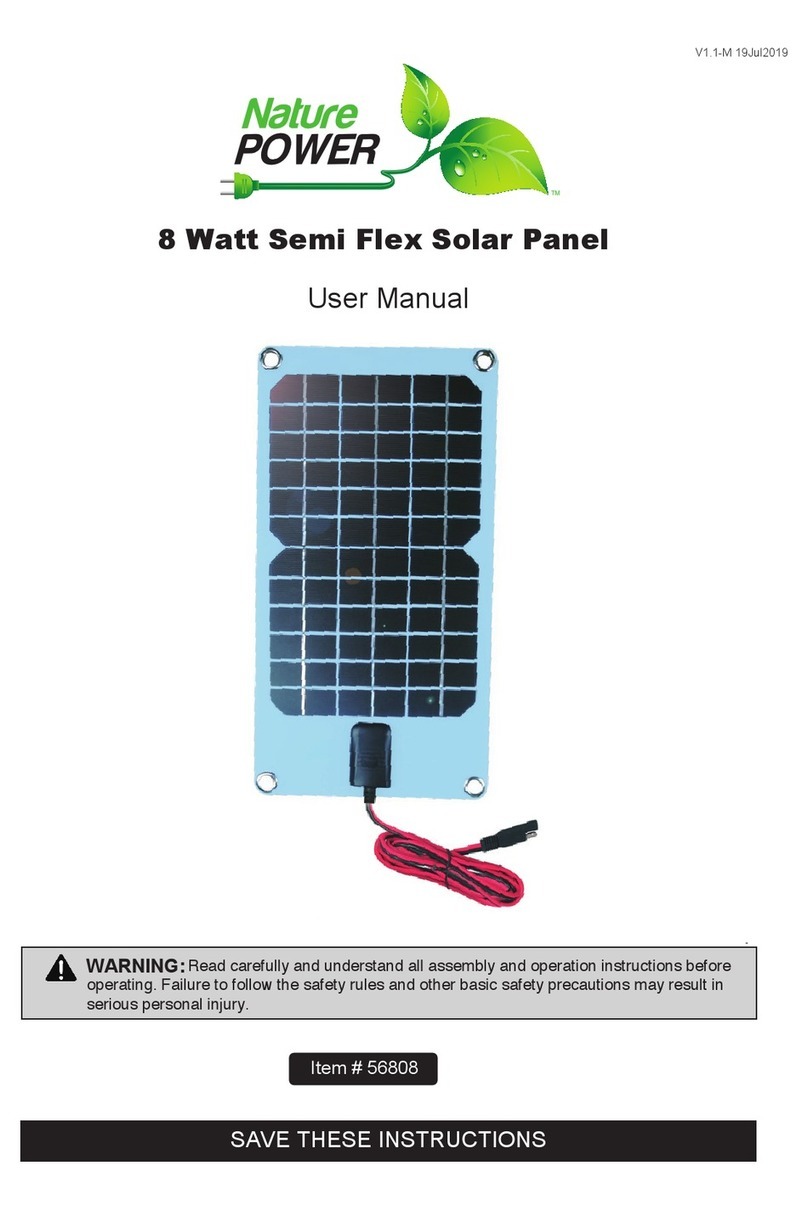
Nature Power
Nature Power 56808 user manual

Dometic
Dometic Buttner MT120FL Installation and operating manual
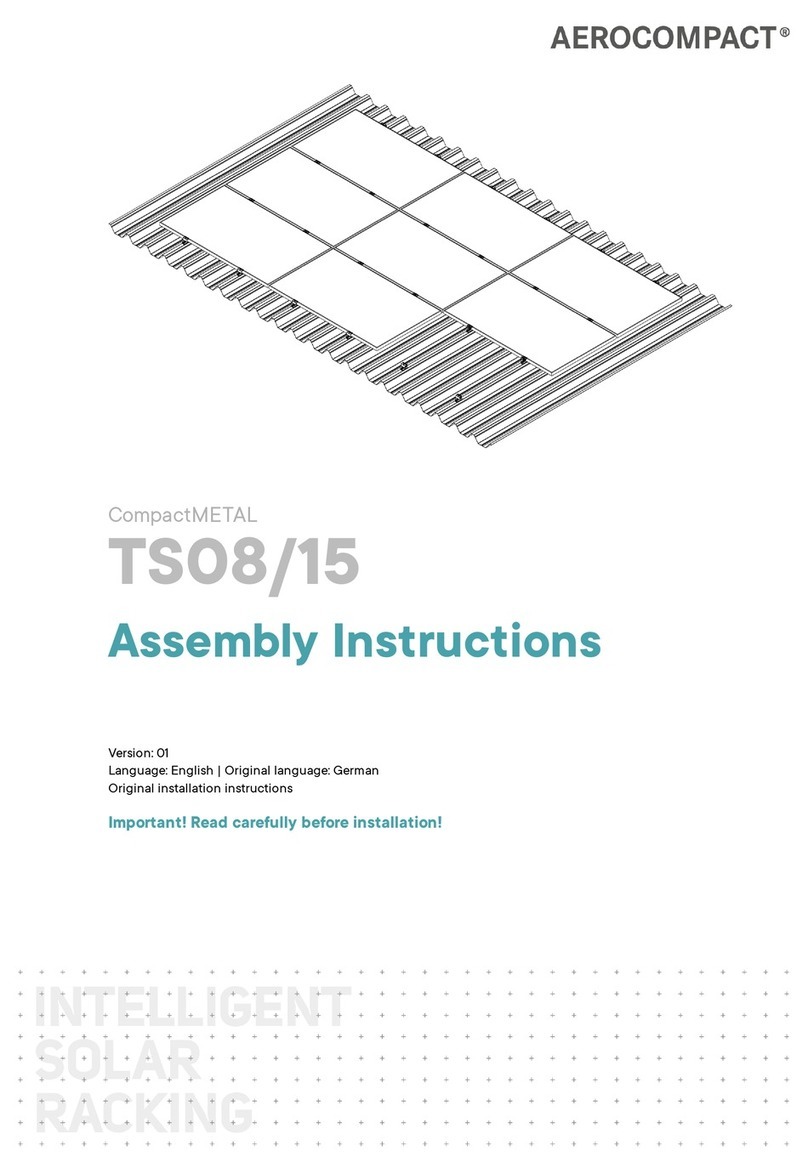
AEROCOMPACT
AEROCOMPACT CompactMETAL TS08 Assembly instructions
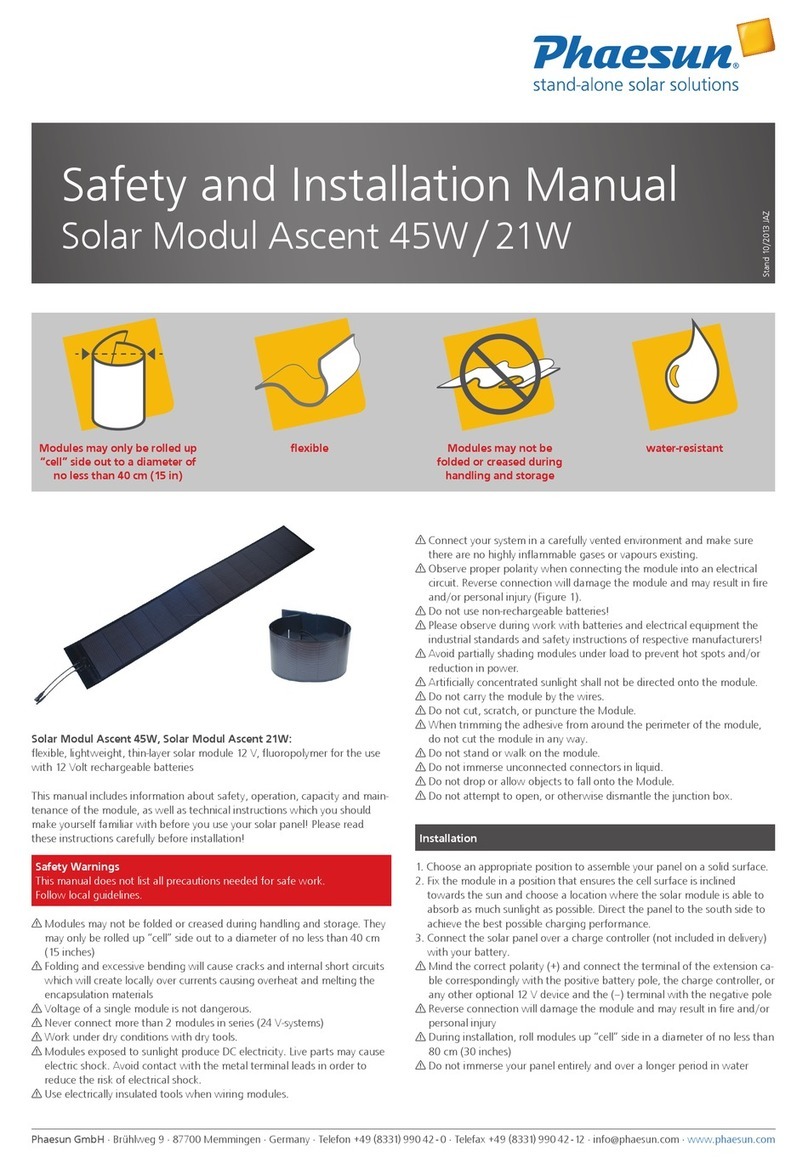
Phaesun
Phaesun Solar Modul Ascent 45W Safety and installation manual

PowerFilm
PowerFilm LightSaver Max manual

Conrad
Conrad 11 03 90 operating instructions
